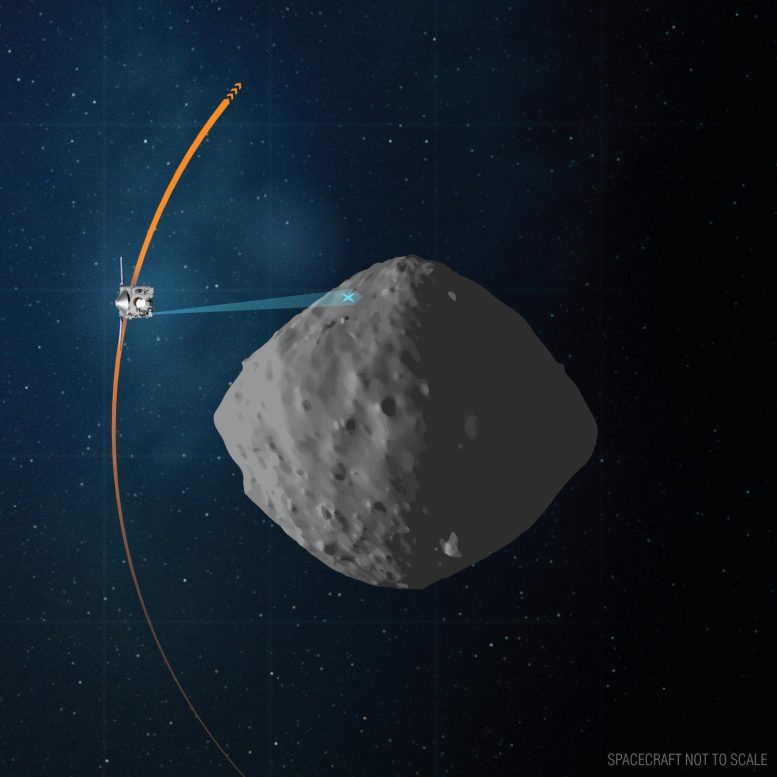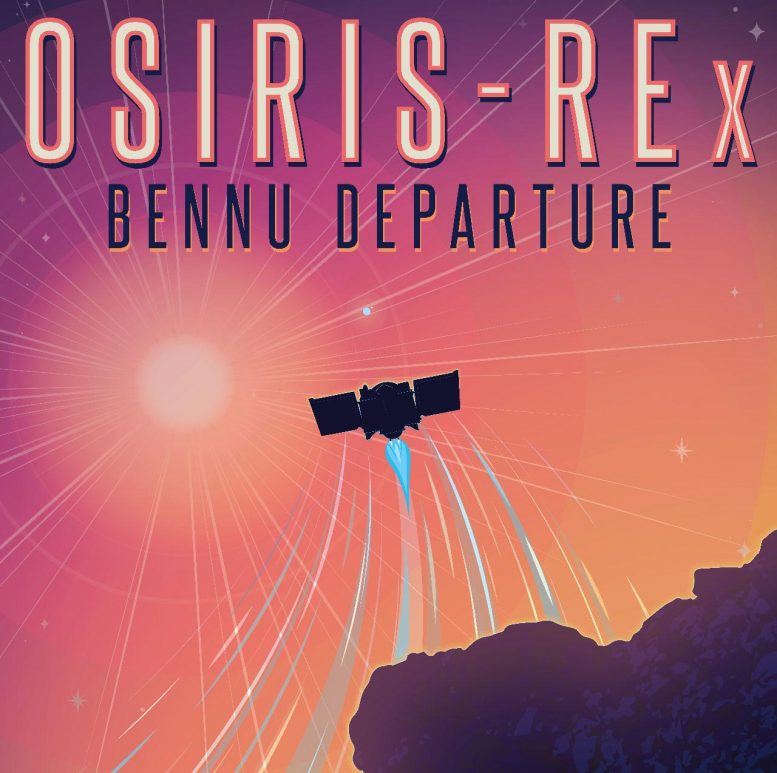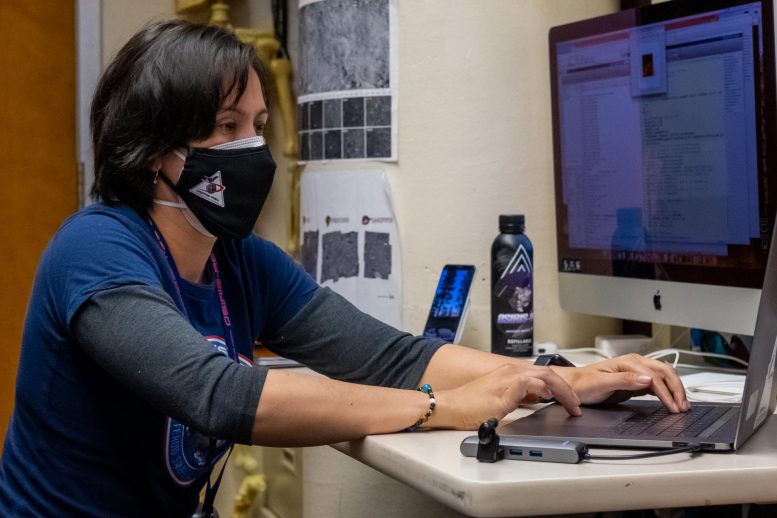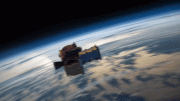
This artist’s concept shows the planned flight path of NASA’s OSIRIS-REx spacecraft during its final flyby of asteroid Bennu, which is scheduled for April 7. Credit: ASA/Goddard/University of Arizona
NASA’s OSIRIS-REx completed its last flyover of Bennu around 6 a.m. EDT (4 a.m. MDT) April 7 and is now slowly drifting away from the asteroid; however, the mission team will have to wait a few more days to find out how the spacecraft changed the surface of Bennu when it grabbed a sample of the asteroid.
The OSIRIS-REx team added this flyby to document surface changes resulting from the Touch and Go (TAG) sample collection maneuver on October 20, 2020. “By surveying the distribution of the excavated material around the TAG site, we will learn more about the nature of the surface and subsurface materials along with the mechanical properties of the asteroid,” said Dr. Dante Lauretta, principal investigator for OSIRIS-REx at the University of Arizona.

This image shows a top-down view of asteroid Bennu, with a portion of the asteroid’s equatorial ridge and northern hemisphere illuminated. It was taken by the PolyCam camera on NASA’s OSIRIS-REx spacecraft on March 4, 2021, from a distance of about 186 miles (300 km). The spacecraft’s cameras are pointed directly at Bennu’s north pole. Two large equatorial craters are visible on the asteroid’s edge (center and center left). The image was obtained during the mission’s Post-TAG Operations phase, as the spacecraft slowly approached Bennu in preparation for a final observational flyby on April 7. Credit: NASA/Goddard/University of Arizona
During the flyby, OSIRIS-REx imaged Bennu for 5.9 hours, covering more than a full rotation of the asteroid. It flew within 2.1 miles (3.5 kilometers) distance to the surface of Bennu – the closest it’s been since the TAG sample collection event.
It will take until at least April 13 for OSIRIS-REx to downlink all of the data and new pictures of Bennu’s surface recorded during the flyby. It shares the Deep Space Network antennas with other missions like Mars Perseverance, and typically gets 4–6 hours of downlink time per day. “We collected about 4,000 megabytes of data during the flyby,” said Mike Moreau, deputy project manager of OSIRIS-REx at NASA’s Goddard Space Flight Center in Greenbelt, Maryland. “Bennu is approximately 185 million miles from Earth right now, which means we can only achieve a downlink data-rate of 412 kilobits per second, so it will take several days to download all of the flyby data.”

NASA invites the public to watch OSIRIS-REx depart from Bennu on NASA.gov and NASA TV, May 10, 2021, at 4 p.m. EDT.
Once the mission team receives the images and other instrument data, they will study how OSIRIS-REx jumbled up Bennu’s surface. During touchdown, the spacecraft’s sampling head sunk 1.6 feet (48.8 centimeters) into the asteroid’s surface and simultaneously fired a pressurized charge of nitrogen gas. The spacecraft’s thrusters kicked up a large amount of surface material during the back-away burn – launching rocks and dust in the process.
OSIRIS-REx, with its pristine and precious asteroid cargo, will remain in the vicinity of Bennu until May 10 when it will fire its thrusters and begin its two-year cruise home. The mission will deliver the asteroid sample to Earth on September 24, 2023.

KinetX Flight Navigator Leilah McCarthy processes navigation images to help target NASA’s OSIRIS-REx final flyby of near-Earth asteroid Bennu. Credit: KinetX Inc./Coralie Adam
NASA’s Goddard Space Flight Center in Greenbelt, Maryland, provides overall mission management, systems engineering, and the safety and mission assurance for OSIRIS-REx (Origins Spectral Interpretation Resource Identification Security – Regolith Explorer). Dante Lauretta of the University of Arizona, Tucson, is the principal investigator, and the University of Arizona also leads the science team and the mission’s science observation planning and data processing. Lockheed Martin Space in Denver built the spacecraft and provides flight operations. Goddard and KinetX Aerospace are responsible for navigating the OSIRIS-REx spacecraft. OSIRIS-REx is the third mission in NASA’s New Frontiers Program, which is managed by NASA’s Marshall Space Flight Center in Huntsville, Alabama, for the agency’s Science Mission Directorate in Washington.









When I was growing up after WWII we all read Science Fiction. It pales in comparison with what is actually done today. Keep up the good work people of the scientific world. There is more to life than baseball and pizza.